Biomedical Engineering Reference
In-Depth Information
O
O
L-Val
D-Leu
H
N
H
N
NH
CH
C
CH
C
CH
3
CH
2
CH
L-Asp
H
2
C
C
O
C
CH
3
CH
HO
CH
CH
3
CH
3
H
2
C
L-Leu
CH
O
C
O
CH
CH
3
CH
3
NH
NH
H
2
C
C
O
O
H
3
C
CH
CH
D-Leu
H
2
C
H
2
C
L-Glu
OH
CH
C
C
O
CH
3
O
CH
3
HN
H
3
C
CH
O
CH
2
b
-Hydroxy
group of
fatty acyl chain
C
CH
NH
O
L-Leu
Figure 10.8
Molecular structure of surfactin, a liposaccharide-type biosurfactant.
10.7 CONCLUSIONS
Bio-based surfactants will account for an increasing share of the surfactants and detergents
market worldwide as the cost of petrochemical feedstocks increases and reaches and/or sur-
passes the cost of bio-based feedstocks; this is anticipated to occur in the near future. Bio-
based feedstocks possess the capacity to meet worldwide demand for surfactants and
detergents. Bioprocessing of bio-based surfactants
via
use of enzymes or microorganisms
(product from the latter referred to as “biosurfactant”) will become increasingly attractive due
to their excellent sustainability profile and their high biocompatibility and biodegradability.
Bioprocessing will become competitive with chemical approaches in terms of operating costs
in the future due to their reduction of energy usage and their narrower selectivity, reducing the
costs of downstream separations. Bioprocessing is particularly robust for niche applications
where highly pure surfactants are needed, such as biomedicine. Further research is needed in
developing more robust biocatalysts and chemo-enzymatic processing methodologies.




Search WWH ::

Custom Search